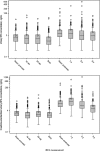Impact of early-life bisphenol A exposure on behavior and executive function in children
- PMID: 22025598
- PMCID: PMC3208956
- DOI: 10.1542/peds.2011-1335
Impact of early-life bisphenol A exposure on behavior and executive function in children
Abstract
Objectives: To estimate the impact of gestational and childhood bisphenol A (BPA) exposures on behavior and executive function at 3 years of age and to determine whether child gender modified those associations.
Methods: We used a prospective birth cohort of 244 mothers and their 3-year-old children from the greater Cincinnati, Ohio, area. We characterized gestational and childhood BPA exposures by using the mean BPA concentrations in maternal (16 and 26 weeks of gestation and birth) and child (1, 2, and 3 years of age) urine samples, respectively. Behavior and executive function were measured by using the Behavior Assessment System for Children 2 (BASC-2) and the Behavior Rating Inventory of Executive Function-Preschool (BRIEF-P).
Results: BPA was detected in >97% of the gestational (median: 2.0 μg/L) and childhood (median: 4.1 μg/L) urine samples. With adjustment for confounders, each 10-fold increase in gestational BPA concentrations was associated with more anxious and depressed behavior on the BASC-2 and poorer emotional control and inhibition on the BRIEF-P. The magnitude of the gestational BPA associations differed according to child gender; BASC-2 and BRIEF-P scores increased 9 to 12 points among girls, but changes were null or negative among boys. Associations between childhood BPA exposure and neurobehavior were largely null and not modified by child gender.
Conclusions: In this study, gestational BPA exposure affected behavioral and emotional regulation domains at 3 years of age, especially among girls. Clinicians may advise concerned patients to reduce their exposure to certain consumer products, but the benefits of such reductions are unclear.
Figures


References
Publication types
MeSH terms
Substances
Grants and funding
LinkOut - more resources
Full Text Sources
Medical

